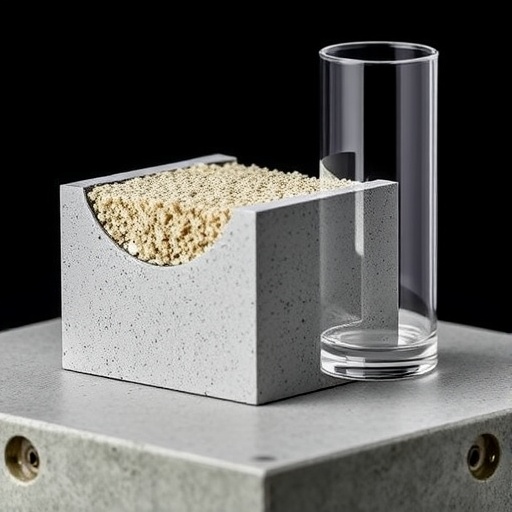In the realm of civil engineering, self-compacting concrete (SCC) has garnered considerable attention for its exceptional flowability and ability to fill forms and voids without requiring mechanical vibration. This innovative material not only enhances construction efficiency but also holds the potential for improved structural integrity. A recent study, led by Kirane et al., has delved into the intricate relationship between aggregate sizes and the fineness of glass powder, assessing their impact on the performance and durability of SCC when utilizing recycled laminated glass.
The utilization of recycled materials in concrete production is not merely a trend, but a necessary advancement toward sustainability in construction. Laminated glass, often discarded as waste, possesses valuable properties that can be harnessed to improve concrete properties. By incorporating recycled laminated glass into the mix design for SCC, researchers aim to not only mitigate waste but also contribute to the circular economy.
Understanding the significance of aggregate size is pivotal when formulating SCC. Larger aggregates tend to enhance strength due to their load-bearing capabilities, while smaller aggregates contribute to improved workability. However, an optimal balance must be achieved, as excessively large aggregates can hinder the flowability of the concrete. The study undertaken by Kirane and colleagues offers insights into how manipulating aggregate size can influence the mechanical characteristics of SCC, particularly when recycled laminated glass is introduced in the mix.
Furthermore, the fineness of glass powder plays a key role in the hydration process of concrete. The larger surface area of fine glass powder can react with alkalis in the cement paste, resulting in enhanced pozzolanic activity. This reaction can lead to a denser microstructure, ultimately improving the durability and strength of the SCC. Kirane et al. meticulously examined the various gradations of glass powder fineness to ascertain how these variations impact the performance metrics and longevity of the concrete.
Durability, a critical factor in the life cycle of concrete structures, encompasses resistance to environmental degradation, chemical attacks, and physical wear. In the study, the authors conducted a series of tests to assess the durability of SCC mixtures incorporating different sizes of aggregates and varying degrees of glass powder fineness. The results indicated that appropriate particle size distributions significantly influenced resistance to water permeability and chemical aggression, which are crucial for extending the lifespan of concrete infrastructures.
Moreover, the research emphasizes the wide-ranging benefits of using recycled laminated glass in construction beyond environmental sustainability. The study showcased how SCC mixtures enriched with different aggregate sizes and glass powder fineness could enhance not only mechanical properties such as compressive and tensile strength but also workability and flow characteristics. This dual advantage positions SCC containing recycled laminated glass as a viable alternative to traditional concrete mixes.
One profound implication of this research is its potential for significant reductions in construction waste. With statistics revealing that millions of tons of laminated glass are discarded annually, employing this material in concrete production could alleviate landfill pressures while promoting resource efficiency. Furthermore, as construction industries around the globe move towards greener practices, the integration of recycled materials is set to become a crucial component in achieving sustainability goals.
As the construction industry faces increasing scrutiny regarding its environmental impact, studies like those conducted by Kirane et al. provide valuable insights into innovative practices that align with broader sustainability objectives. With the ability to produce composites that leverage waste materials, engineers and architects can redefine construction methodologies, promoting a future where infrastructure and sustainability coexist harmoniously.
In conclusion, the research conducted by Kirane and his team is not just a step forward in the realm of concrete technology; it represents a shift toward a more sustainable future in construction. This study illuminates the intricacies of how varying aggregate sizes and glass powder fineness affect the performance and durability of self-compacting concrete when integrated with recycled materials. The findings advocate for the reevaluation of traditional construction practices and encourage the adoption of innovative solutions that prioritize environmental stewardship without compromising structural integrity.
This pioneering work invites further exploration and experimentation in the quest for sustainable construction materials. As more researchers unlock the potential of recycled products in concrete applications, the industry stands on the cusp of a transformative era, where waste not only becomes a resource but also a cornerstone of advanced building practices.
Subject of Research: Effects of aggregate size and glass powder fineness on the performance and durability of self-compacting concrete with recycled laminated glass.
Article Title: Effects of aggregate size and glass powder fineness on the performance and durability of self-compacting concrete with recycled laminated glass.
Article References:
Kirane, S., Melais, F.Z., Arabi, N. et al. Effects of aggregate size and glass powder fineness on the performance and durability of self-compacting concrete with recycled laminated glass.
Environ Sci Pollut Res (2025). https://doi.org/10.1007/s11356-025-37005-y
Image Credits: AI Generated
DOI: 10.1007/s11356-025-37005-y
Keywords: self-compacting concrete, recycled laminated glass, aggregate size, glass powder fineness, durability, sustainability, concrete technology, pozzolanic activity.




